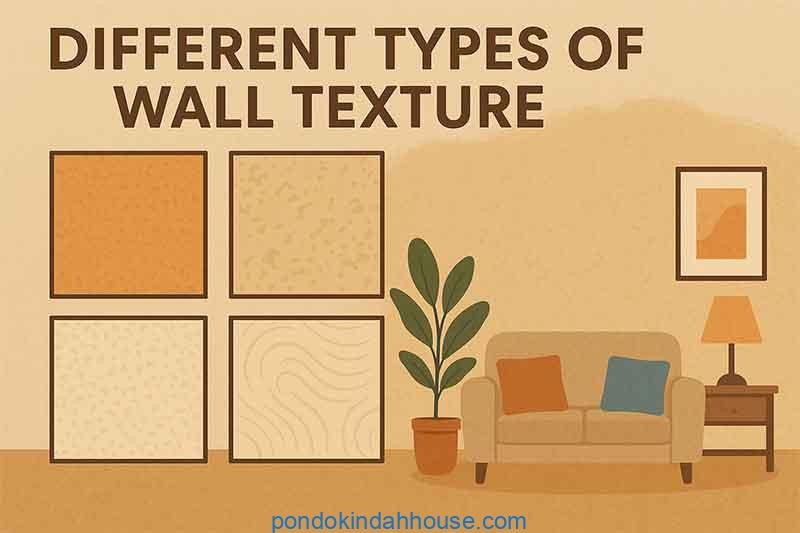Different Types of Wall Texture: A Complete Guide for Every Home

Different Types of Wall Texture: A Complete Guide for Every Home – When it comes to transforming the look and feel of a room, paint color is often the first thing that comes to mind. But there’s another design element that can make an even bigger impact — wall texture. Textured walls add depth, personality, and visual interest to your home. They can make a plain wall look luxurious, cozy, or artistic, depending on the style you choose.
In this guide, we’ll explore the different types of wall texture, how they’re created, and which styles best suit different rooms or design goals. Whether you’re renovating your home, decorating a new space, or just exploring creative ideas, understanding wall textures will help you make smarter design choices.
What Is Wall Texture?
Wall texture refers to the pattern or finish applied to the surface of walls and ceilings. It’s achieved through various application methods such as brushing, spraying, rolling, or troweling materials like joint compound, plaster, or paint. The result is a unique surface that adds visual dimension and hides imperfections.
Wall textures serve both aesthetic and practical purposes. They can disguise minor flaws, cracks, or uneven drywall seams. They also help with sound absorption and can make a room feel warmer or cozier. In modern interior design, texture has become a key element for adding character without overwhelming the space.
Why Wall Texture Matters
A textured wall does more than just change the look of a room. It creates mood, atmosphere, and style. Smooth walls often feel clean and minimalistic, while textured walls feel dynamic and engaging.
The right texture can also influence lighting. When light hits a textured surface, it creates shadows and highlights that add movement and depth. This interaction gives walls a more organic and tactile feel — something flat paint simply can’t achieve.
If you’re thinking about home value, wall texture can also be an advantage. Certain textures give your interiors a high-end or custom-built look, making the space more appealing to potential buyers.
Main Categories of Wall Texture
Before exploring specific styles, it’s important to understand that wall textures fall into two general categories — hand-applied and spray-applied textures.
Hand-Applied Wall Textures
These textures are created manually using tools like brushes, trowels, or sponges. Each result is unique because it depends on the artisan’s technique and movement. Hand-applied textures are popular for traditional, rustic, or artistic interiors.
Spray-Applied Wall Textures
These are created using a spray gun or hopper, often with a mixture of drywall compound and water. The texture can then be left as-is or knocked down slightly with a knife or trowel. This method is faster, more consistent, and common in modern homes and large construction projects.
Different Types of Wall Texture
Let’s take a closer look at the most common and stylish types of wall textures you can use.
1. Orange Peel Texture
The orange peel texture is one of the most recognizable and widely used wall textures in modern homes. It gets its name because the finished surface resembles the slightly bumpy skin of an orange.
It’s usually created using a spray gun that applies a thin, even layer of watered-down joint compound onto the wall. Once it dries, it forms a subtle, pebbled look that adds just enough texture without feeling too rough.
This type is perfect for those who want a clean, modern look with a bit of character. It also hides minor flaws in drywall better than a smooth finish.
Best for: Living rooms, bedrooms, hallways, and ceilings
Pros: Easy to apply, hides imperfections, modern aesthetic
Cons: Slightly harder to patch seamlessly
2. Knockdown Texture
Knockdown texture is a step up from the orange peel finish. After the compound is sprayed onto the wall, a trowel or knockdown knife is used to gently flatten the peaks, creating a mottled, stucco-like appearance.
This gives a softer, more natural look than orange peel. It’s one of the most popular modern textures because it blends contemporary style with a touch of rustic charm.
Best for: Living rooms, hallways, and large open spaces
Pros: Elegant look, hides flaws well, versatile style
Cons: Slightly more labor-intensive
3. Popcorn Texture
Popcorn texture, sometimes called acoustic texture, is most often used on ceilings rather than walls. It was a popular choice in homes built between the 1950s and 1980s. The surface has a bumpy, cottage cheese–like texture that helps dampen sound.
Although not as trendy today, popcorn texture still works well in spaces where sound control matters, like home theaters or basements.
Best for: Ceilings, home theaters, or older homes maintaining vintage style
Pros: Excellent sound absorption, hides ceiling imperfections
Cons: Difficult to clean, dated appearance
4. Sand Swirl Texture
The sand swirl texture combines visual appeal with a handcrafted touch. It’s created by mixing sand with primer or joint compound and applying it with a brush or sponge in overlapping circular patterns.
The result is a soft, flowing look that feels artistic and slightly rustic. It reflects light beautifully and can make large walls look more dynamic without overwhelming the space.
Best for: Bedrooms, dining rooms, or artistic interiors
Pros: Elegant and custom-looking, visually softens large spaces
Cons: Requires skill to apply evenly
5. Skip Trowel Texture
Skip trowel is another hand-applied texture that’s popular in Mediterranean or Tuscan-style interiors. It’s made by applying thin layers of joint compound using a curved trowel, then lightly skipping it across the surface. This technique creates irregular patterns with both smooth and raised areas.
Each wall ends up unique, with a handcrafted, old-world charm.
Best for: Living rooms, dining areas, or Mediterranean-inspired spaces
Pros: Artistic look, hides flaws, timeless appeal
Cons: Requires practice and skill to master
6. Slap Brush Texture
Also known as “crow’s foot” or “stomp brush,” this texture is created by applying joint compound and then pressing a special brush into it repeatedly to form fan-like patterns. The overlapping strokes create a unique, bold texture that draws attention.
It adds a lot of visual depth and works great for ceilings or accent walls.
Best for: Ceilings, accent walls, or rustic-style interiors
Pros: Eye-catching, customizable
Cons: Can look too busy in small rooms
7. Venetian Plaster
Venetian plaster is one of the most luxurious and sophisticated wall textures. Made from marble dust mixed with plaster, it’s applied in multiple thin layers and then polished to a smooth, glossy finish with subtle depth and movement.
It originated in Italy and remains popular in upscale interiors for its elegant, timeless feel. Venetian plaster can be tinted in various colors and finishes — from matte to high shine — making it versatile for both modern and classical designs.
Best for: Living rooms, dining areas, or luxury spaces
Pros: High-end look, durable, adds visual depth
Cons: Expensive, professional installation recommended
8. Comb Texture
Comb texture is created using a toothed trowel or comb tool that’s dragged through the wet compound to make linear or curved designs. The most common pattern is the half-fan or rainbow style, which adds an artistic flair.
It’s often used to highlight specific walls or as a creative accent in rooms with simple décor.
Best for: Feature walls, artistic or eclectic interiors
Pros: Creative, customizable
Cons: Can be hard to repair if damaged
9. Knockdown Skip Trowel Hybrid
This hybrid combines the random beauty of skip trowel texture with the soft, flattened look of knockdown finish. The result is a more refined, contemporary wall texture that still feels handcrafted.
It’s especially effective in modern rustic or transitional spaces where you want warmth and sophistication together.
Best for: Living rooms, hallways, and open-plan homes
Pros: Modern, stylish, hides imperfections well
Cons: Requires experience to apply properly
10. Smooth Finish
While technically not a “texture,” smooth walls deserve a mention. A perfectly smooth finish is clean, modern, and timeless. It’s often chosen for minimalist or contemporary interiors where the focus is on furniture and color rather than the wall surface.
Smooth walls require more prep work to eliminate any flaws, but the result is sleek and elegant.
Best for: Modern homes, offices, and minimalist spaces
Pros: Clean look, versatile, easy to paint
Cons: Shows imperfections easily
Choosing the Right Wall Texture for Your Space
Selecting the perfect texture depends on your design goals, lighting, and lifestyle. For example, if you want a sleek modern look, go for smooth or orange peel finishes. If you prefer rustic charm, skip trowel or slap brush might be your best options.
Here are a few tips to guide your choice
- Consider lighting. Soft lighting highlights subtle textures like orange peel or knockdown beautifully.
- Think about maintenance. Smooth finishes are easy to clean, while heavily textured ones can trap dust.
- Match your décor. Modern interiors pair well with subtle textures. Traditional or artistic spaces benefit from more intricate finishes.
- Test a sample area. Always try a small section first to see how it looks when dry and under your room’s lighting.
Application and Maintenance Tips
If you’re applying wall texture yourself, use the right tools and consistency for your compound. Always start with a clean, primed wall. For spray textures, practice on scrap drywall first to get the spray pressure and technique right.
After applying, allow proper drying time before painting. Lightly sanding between coats can help smooth out rough spots.
To maintain textured walls, use gentle cleaning methods. Avoid scrubbing too hard, especially on delicate or hand-applied textures. A damp microfiber cloth or vacuum brush attachment works best.
Modern Trends in Wall Texturing
Wall texture trends have evolved significantly. Today’s homeowners often combine different textures across rooms to create contrast and interest. For example, smooth walls in the living room paired with a skip trowel finish in the dining area.
Subtle, natural-looking textures are in style, inspired by materials like stone, clay, and plaster. Earthy finishes that mimic natural imperfections are gaining popularity, especially in minimalist and Scandinavian interiors.
Some designers also use digital tools and custom stencils to create personalized textures, merging technology with craftsmanship.
Final Thoughts
Wall texture is more than just decoration. It’s a design tool that changes how a room feels and interacts with light. From subtle orange peel to luxurious Venetian plaster, there are countless ways to express your style and elevate your space.
When you understand the different types of wall texture and their unique qualities, you can make informed choices that balance beauty, practicality, and personality. Whether you prefer a modern minimalist look or a handcrafted traditional vibe, the right texture will bring your walls — and your entire room — to life.
Related Posts:




